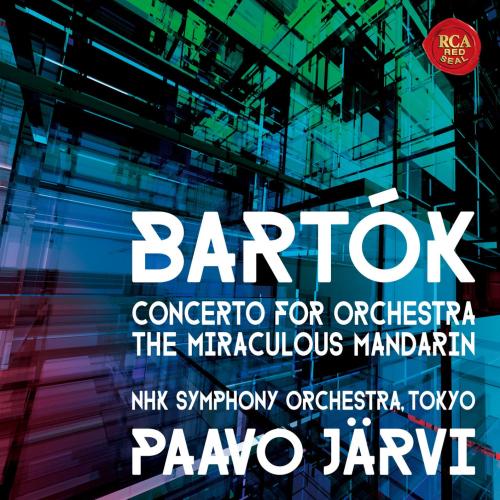
Bartok: Concerto for Orchestra / The Miraculous Mandarin Suite NHK Symphony Orchestra, Tokyo & Paavo Järvi
Album Info
Album Veröffentlichung:
2023
HRA-Veröffentlichung:
12.04.2023
Label: Sony Music Labels Inc.
Genre: Classical
Subgenre: Concertos
Interpret: NHK Symphony Orchestra, Tokyo & Paavo Järvi
Komponist: Béla Bartok (1881-1945)
Das Album enthält Albumcover
Entschuldigen Sie bitte!
Sehr geehrter HIGHRESAUDIO Besucher,
leider kann das Album zurzeit aufgrund von Länder- und Lizenzbeschränkungen nicht gekauft werden oder uns liegt der offizielle Veröffentlichungstermin für Ihr Land noch nicht vor. Wir aktualisieren unsere Veröffentlichungstermine ein- bis zweimal die Woche. Bitte schauen Sie ab und zu mal wieder rein.
Wir empfehlen Ihnen das Album auf Ihre Merkliste zu setzen.
Wir bedanken uns für Ihr Verständnis und Ihre Geduld.
Ihr, HIGHRESAUDIO
- Béla Bartók (1881 - 1945): The Miraculous Mandarin Suite, Op. 19, BB 82 / Sz 73 I. Introduction (street noises). The command of the hoodlums directed at the girl.:
- 1 Bartók: The Miraculous Mandarin Suite, Op. 19, BB 82 / Sz 73 I. Introduction (street noises). The command of the hoodlums directed at the girl. 02:38
- The Miraculous Mandarin Suite, Op. 19, BB 82 / Sz 73 II. The girl's first inviting gestures (clarinet solo), in response to which the old gentleman appears, who gets thrown out in the end by th.:
- 2 Bartók: The Miraculous Mandarin Suite, Op. 19, BB 82 / Sz 73 II. The girl's first inviting gestures (clarinet solo), in response to which the old gentleman appears, who gets thrown out in the end by the hoodlums. 03:43
- The Miraculous Mandarin Suite, Op. 19, BB 82 / Sz 73 III. The girl's second inviting gestures, upon which appears the young lad, who is also thrown out.:
- 3 Bartók: The Miraculous Mandarin Suite, Op. 19, BB 82 / Sz 73 III. The girl's second inviting gestures, upon which appears the young lad, who is also thrown out. 03:22
- The Miraculous Mandarin Suite, Op. 19, BB 82 / Sz 73 IV. The girl's third inviting gestures. The mandarin appears (tutti ff).ird decoy game.:
- 4 Bartók: The Miraculous Mandarin Suite, Op. 19, BB 82 / Sz 73 IV. The girl's third inviting gestures. The mandarin appears (tutti ff).ird decoy game. 02:34
- The Miraculous Mandarin Suite, Op. 19, BB 82 / Sz 73 V. The girl's seductive dance before the mandarin (at first slow, then increasingly faster Waltz).:
- 5 Bartók: The Miraculous Mandarin Suite, Op. 19, BB 82 / Sz 73 V. The girl's seductive dance before the mandarin (at first slow, then increasingly faster Waltz). 04:56
- The Miraculous Mandarin Suite, Op. 19, BB 82 / Sz 73 VI. The mandarin catches up with the girl after an ever wilder chase.:
- 6 Bartók: The Miraculous Mandarin Suite, Op. 19, BB 82 / Sz 73 VI. The mandarin catches up with the girl after an ever wilder chase. 02:06
- Concerto for Orchestra, BB 123 / Sz 116 I. Introduzione:
- 7 Bartók: Concerto for Orchestra, BB 123 / Sz 116 I. Introduzione 10:04
- Concerto for Orchestra, BB 123 / Sz 116 II. Gioco delle coppie:
- 8 Bartók: Concerto for Orchestra, BB 123 / Sz 116 II. Gioco delle coppie 06:41
- Concerto for Orchestra, BB 123 / Sz 116 III. Elegia:
- 9 Bartók: Concerto for Orchestra, BB 123 / Sz 116 III. Elegia 07:45
- Concerto for Orchestra, BB 123 / Sz 116 IV. Intermezzo interrotto:
- 10 Bartók: Concerto for Orchestra, BB 123 / Sz 116 IV. Intermezzo interrotto 04:18
- Concerto for Orchestra, BB 123 / Sz 116 V. Finale:
- 11 Bartók: Concerto for Orchestra, BB 123 / Sz 116 V. Finale 09:36
Info zu Bartok: Concerto for Orchestra / The Miraculous Mandarin Suite
Masterpieces of the 20th Century: The final album of Paavo Järvi and the NHK Symphony Orchestra... Two masterpieces of Bartók's music.
The Bartók album that marked the end of an era for Paavo Järvi and the NHK Symphony Orchestra is now available. It is a live recording of the Bartók Pro, which he fully committed to in his final season as principal conductor, and is the counterpart to the Trilogy consisting of "Strings, Chere," "Divertimento," and "Dance Suite," released in 2019.
Järvi's first recording, "The Wonderful Chinese Officials," uses a suite version and is a terrific performance that synergizes the high virtuosity of the NHK Symphony Orchestra with Järvi's close drive. The concerto for orchestra is Järvi's first re-recording in 16 years, but this is a reprise of a popular work that was selected as one of the "Top 10 Concerts" when Järvi became chief conductor of the NHK Symphony Orchestra, and it is a fulfilling performance that clearly reflects the fruits and weight of the musical activities accumulated by this duo. Here is a new Bartók sound world, deeply marked by Järvi's achievement of combining and developing the German sound and high functionality of the N Symphony Orchestra.
Paavo Järvi discusses two of Bartók's orchestral masterpieces:
The Mysterious Chinese Official was written between 1918 and 1924. I believe that an essential part of the work has a special relationship to this period. After the end of World War I, composers were reluctant to paint a brush with music that celebrated deep emotion and affection. The war that had just ended was too brutal and inhuman. Art that had been conceived in terms of beauty, warmth, and loveliness was felt to be inappropriate. The resulting music tended toward dynamic elements, sometimes rough and mechanical (the description often given to such works is "primitivism," as in Stravinsky's "Rite of Spring"). Despite its exquisite formatting, skillful orchestration, and colorful instrumentation, "The Wonderful Chinese Official" is a work that deliberately refuses to be refined. I am fascinated by the savagery and gruesome character of Bartók's blend of radicalism and thoroughgoing barbarism.
Few orchestral works written in the middle of the 20th century have gained the same level of recognition as the Concerto for Orchestra. It is possible that Bartók's writing was motivated by a desire for wide public acceptance, a product of his period of severe economic hardship. While he wrote music of little complexity, perhaps systematically, I believe that the means of expression he employed show a degree of deepening. He made the highly intricate material accessible to his audience by adding his own touches. Like the relatively well-known Piano Concerto No. 3, the "Concerto for Orchestra" has an element of simplification that, in my opinion, even enhances its greatness. This process of deepening seems to have been followed by many composers, such as Prokofiev, Shostakovich, and Mahler (especially the 9th Symphony), to name a few. They all reached this state at the end of their lives. Their musical vocabulary has all become simpler, more transparent and direct, and though contradictory in form, they say more while being less complex.
This album is the second Bartók album by myself and the NHK Symphony Orchestra. The works on this disc are all as demanding as solo concertos in terms of difficult passages for all instruments, but the individual musicians and sections are superb, and the orchestra as a whole is at its best. I hope listeners will enjoy what we have accomplished." (Translated by Issei Kiba, from the manufacturer's materials)
NHK Symphony Orchestra
Paavo Järvi, conductor
Paavo Järvi
Estonian Grammy Award-winning conductor Paavo Järvi is widely recognised as one of today’s most eminent conductors, enjoying close partnerships with the finest orchestras around the world. He serves as Chief Conductor of the Tonhalle Orchester-Zürich, as the long-standing Artistic Director of The Deutsche Kammerphilharmonie Bremen since 2004, and as both the founder and Artistic Director of the Estonian Festival Orchestra. From the start of the 2022/ 23 season he is also Honorary Conductor of the NHK Symphony Orchestra.
In his fourth season as Music Director of Tonhalle-Orchester Zürich, Paavo Järvi embarks on a new Bruckner cycle in the recently refurbished Grosse Tonhalle and completes the Mendelssohn Cycle, which was the main composer focus of the previous year. He closes the 2022 / 23 season with performances and a recording of Beethoven’s Fidelio in a new semi-staged production, directed by Eva Buchmann. Recent releases include a disc celebrating the 75th birthday of John Adams and a recording of Brucnkner Symphony No. 7, both on Alpha Classics.
The NHK Symphony Orchestra
was formed on October 5, 1926 under the name of the New Symphony Orchestra, and in 1951, it came under the financial support of the Japan Broadcasting Corporation (NHK) and was renamed the NHK Symphony Orchestra. During those years it established itself as the leading orchestra in Japan under the direction of Joseph Rosenstock who was invited from Germany as Chief Conductor. The subscription concert series, the main pillar of its performances, started on February 20, 1927, and has been maintained without any interruption even through the time of the Second World War. Since then, the orchestra has continually invited the world's most renowned conductors of the time, including Herbert von Karajan, Ernest Ansermet, Joseph Keilberth and Lovro von Matačić, Wolfgang Sawallisch and Lorin Maazel to name but a few, and worked with some of the world's most celebrated soloists to present innumerable outstanding performances which have deeply remained in the classical music history of Japan.
Annually the orchestra performs about 120 concerts across Japan including 54 subscription concerts, which are broadcast nationwide via NHK television and FM radio and some of which are introduced to the world through international broadcast services. It made its first appearance at the Salzburg Festival in August 2013, and in the spring of 2020, presented concerts in nine major European cities including Berlin and Vienna, earning high artistic acclaim for its performances and activities.
In recent years, the orchestra has been engaged in a variety of programs to inspire the next generation of musicians such as NHKSO Academy to foster future orchestra musicians and NHK Music Club for Children to teach children the joy of music through hands-on experience by visiting schools nationwide. At the closing ceremony of the Tokyo 2020 Olympic Games, it performed the Olympic Hymn, and Fly High (sung by milet), NHK's winter sports theme song, for the occasion of the Beijing Winter Olympics in February 2022.
Throughout the entire 2020-21 season, the orchestra faced an unprecedented situation to have to cancel its subscription series due to the COVID-19 pandemic, however, with the help from infectious disease experts as well as scientific evidence, it presented special concerts every month by applying every possible countermeasure against the infection. It resumed the subscription series in the 2021-22 season, delivering music to a public whose daily lives are still grossly restricted.
Conductors who are closely associated with the NHK Symphony Orchestra include Fabio Luisi (Chief Conductor to assume from September 2022), Charles Dutoit (Music Director Emeritus), Herbert Blomstedt (Honorary Conductor Laureate), Vladimir Ashkenazy (Conductor Laureate), Paavo Järvi (Honorary Conductor to assume from September 2022), Yuzo Toyama (Permanent Conductor) and Tadaaki Otaka (Permanent Conductor).
Dieses Album enthält kein Booklet









